ISSN ONLINE(2278-8875) PRINT (2320-3765)
ISSN ONLINE(2278-8875) PRINT (2320-3765)
SyedaRafath Ara1 and Dr. S. N. Mulgi2
|
| Related article at Pubmed, Scholar Google |
Visit for more related articles at International Journal of Advanced Research in Electrical, Electronics and Instrumentation Engineering
This paper presents the design of a simple rectangular microstrip antenna (RMSA) for wide bandwidth and large virtual size reduction. The conventional RMSA has been modified by using only microstripline feed with reduced substrate area. The modified RMSA gives 3.71% of bandwidth and resonates at 4.59 GHz. This bandwidth has been enhanced to 90.70% with a virtual size reduction of 33.33% by using a ground plane 64.50% smaller than the ground plane used in the modified RMSA. If the ground plane is reduced to 74.50% the antenna gives a highest virtual size reduction of 50%. The enhancement of bandwidth and virtual size reduction are achieved without altering the size of the rectangular patch and nature of broadband radiation characteristics. The proposed antennas are simple in their design and they may find application in WLAN.
Keywords |
| Modified rectangular microstrip antenna, single microstripline feed, bandwidth, virtual size reduction, WLAN. |
INTRODUCTION |
| Today’s wireless communication system requires that an antenna should not only have the wide bandwidth but also a simple structure, compact size, easy integration with the system circuit, stable gain and suitable radiation pattern to cover many applications [1-6]. Microstrip patch antenna is a low profile, light weight, low cost, ease of installation and planar configuration device. But the main drawback is that it shows narrow bandwidth.Many researchers have made an effort to overcome the problem of narrow bandwidth. Various techniques are available in the literature for increasing the bandwidth these include use of different patch configuration, introducing slots on the patch, use of various feeding techniques, use of stacked patches [7-16] etc. In the present scenario the requirement is that, the antenna should have wide bandwidth and compact in size. Because wide bandwidth antennas are more attractive for wireless communication applications. The large ground plane used for the conventional printed antenna is one of the main limitations. Recently the changes in the ground plane have received much attention in improving the antenna parameters. The modified geometry of RMSA and the effect of change in the ground plane of modified RMSA have been reported for wide bandwidth and large virtual size reduction. This kind of study is found to be rare in the literature. |
ANTENNA STRUCTURE AND DESIGN |
| The geometries of conventional rectangular microstrip antenna (CRMSA), modified rectangular microstrip antenna (MRMSA) and Antenna-1 are shown in Fig. 1 to 3 respectively. These antennas are located in X-Y plane. As shown in Fig. 1 the CRMSA consists of rectangular geometry patch of length ‘L’ and width ‘W’ fed by using microstripline feed of length ‘Lf’ and width ‘Wf’. The quarter wave transformer of length ‘Lt’ and width ‘Wt’ is used between the patch and 50Ω microstripline feed for matching their impedances. The bottom surface is full copper which is a ground plane. In Fig. 2 the CRMSA is modified by using single microstripline feed with reduced substrate area which is 25% smaller than the substrate area used for the construction of CRMSA. The geometry of Antenna-1 is as shown in Fig. 3. In this case the top surface of this antenna shown in Fig. 3(a) is kept same as that of Fig. 2 whereas the copper layer of the bottom surface shown in Fig. 3(b) is varied. |
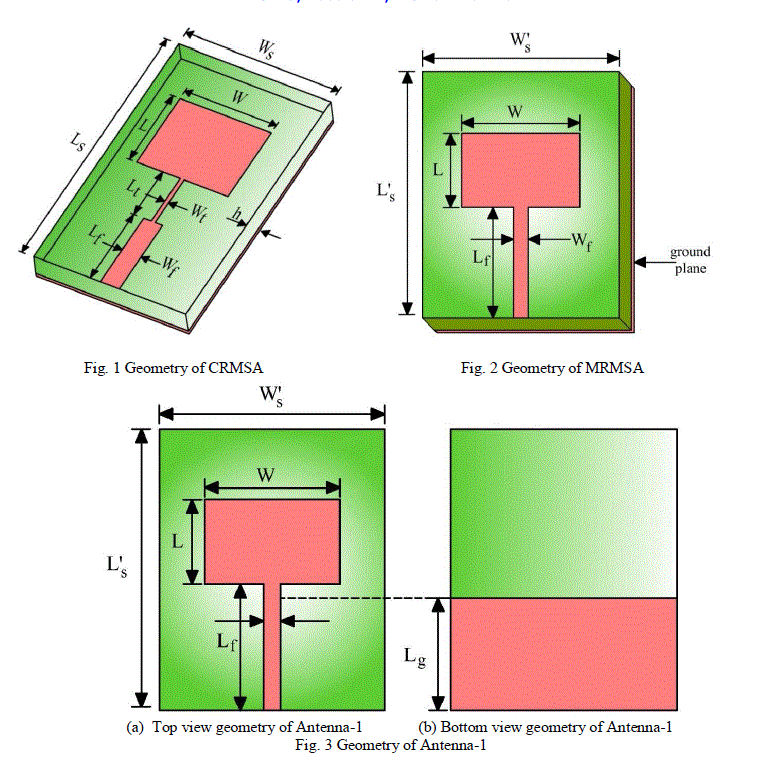 |
| The total area of CRMSA is 8 × 8 cm2,MRMSA and Antenna-1 is 6 × 6 cm2. The CRMSA has been designed for 3 GHz on easily available modified glass epoxy substrate material of thickness 0.16 cm with dielectric constant of 4.2.The various antenna parameters of figures 1, 2 and 3 are given in Table-1. |
 |
RESULTS AND DISCUSSION |
| The simulation is carried out by using Ansoft high frequency structure simulation (HFSS) software. The proposed antennas are operates between 1-5 GHz. Figure 4 and 5 shows the variation of return loss versus frequency of CRMSA and MRMSA respectively. From Fig. 4 it is clear that, the CRMSA resonates at 2.66 GHz which is very close to the designed frequency of 3GHz. The antenna resonates between 2.60 to 2.71 GHz and bandwidth is found to be 3.67%. The peak gain of this antenna is found to be 3.66 dB. From Fig. 5 it is clear that, the MRMSA resonates at 4.59 GHz gives 3.71% of bandwidth. The shift in resonance frequency fr from design frequency 3 GHz to 4.59 GHz is due to the coupling effect of microstripline feed and patch. |
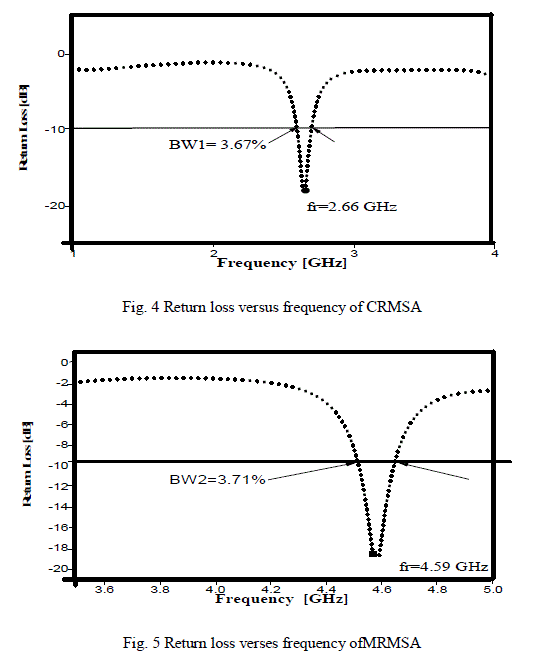 |
| Figure 6 shows the variation of return loss versus frequency of Antenna-1 when Lg=2.13, 1.93, 1.73, 1.53 cm. From this figure it is observed that whenLg = 2.13 cm the bandwidth of MRMSA shown in Fig. 5 has been enhanced to 90.70%. By comparing the lowest cut off frequency of this antenna when its return loss reaches -10 dB to that of lowest cut off frequency of CRMSA the virtual size reduction is found to be 33.33%. This shows that the variation of ground plane is quite effective in enhancing the bandwidth and obtaining the virtual size reduction of an antenna. The peak gain of this antenna in its operating band is found to be 2.17 dB. |
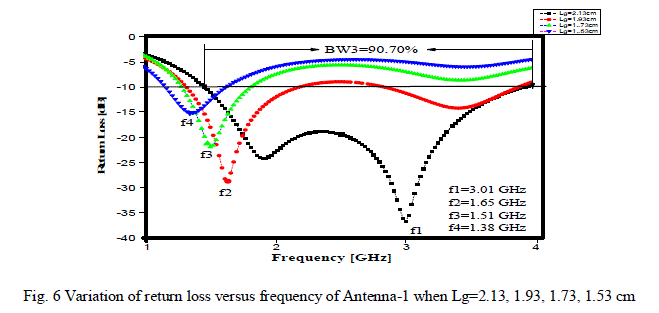 |
| When size of the ground plane is varied to 1.93, 1.73 and 1.53 cm the obtained virtual size reduction, bandwidth and gain is given in the Table-2. From this table it is clear that, the maximum virtual size reduction of 50% is achieved when size of ground plane is kept at 1.53 cm. However the gain of the antenna is maximum (3.56 dB) when Lg is 1.73cm but in this case the antenna gives marginally lesser bandwidth which is 34.5%. Hence Lg is the parameter and may be varied to control bandwidth, virtual size reduction and gain of the antenna. Figure 7 (a) and (b) shows the variation of bandwidth and virtual size reduction with respect to change in the value of Lg. |
 |
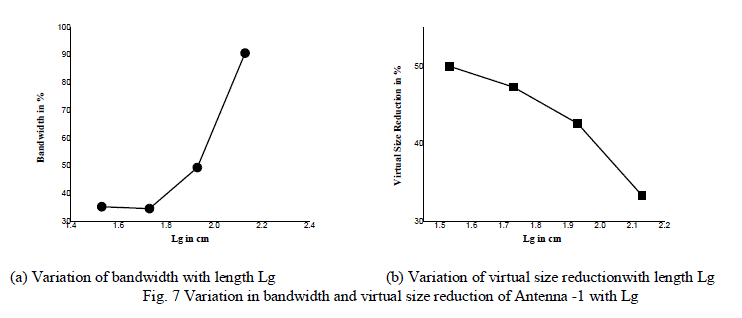 |
| The radiation characteristics of CRMSA, MRMSA and Antenna-1 are also studied. The typical E and H-plane radiation patterns of the proposed antennas are illustrated in Fig. 8 to 10 measured at their resonant frequency. From Fig. 8 to 13 it is clear that, the patterns are broadsides and linearly polarised. |
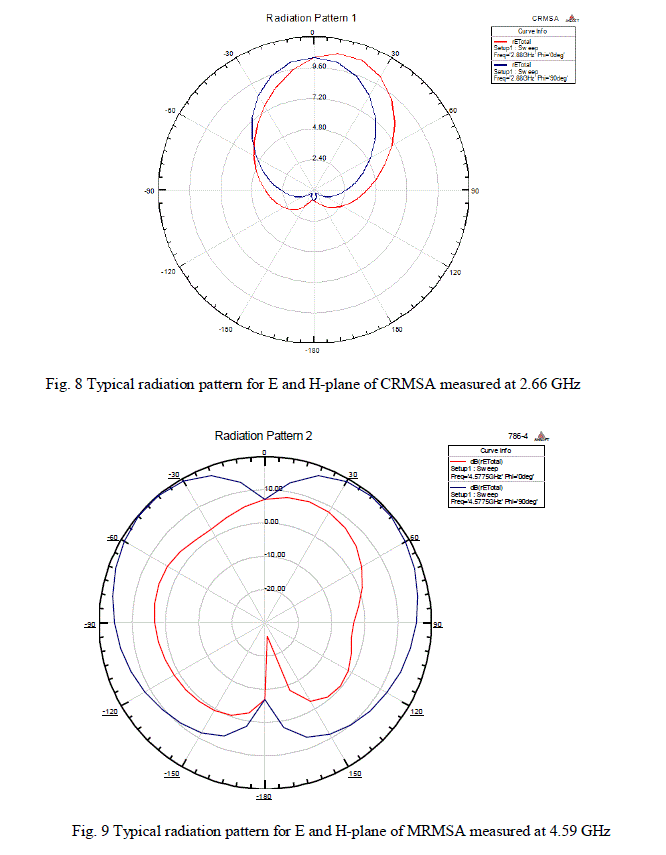 |
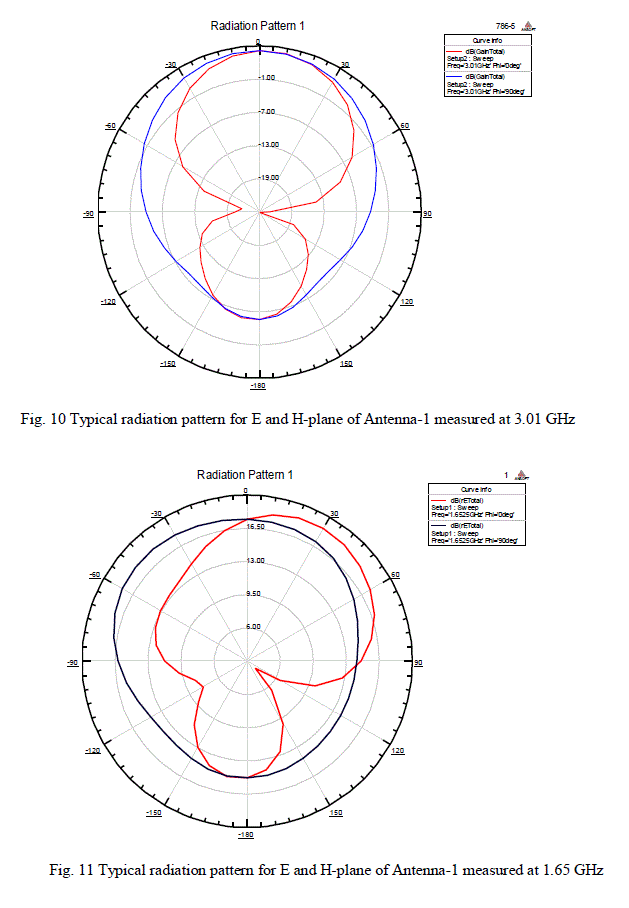 |
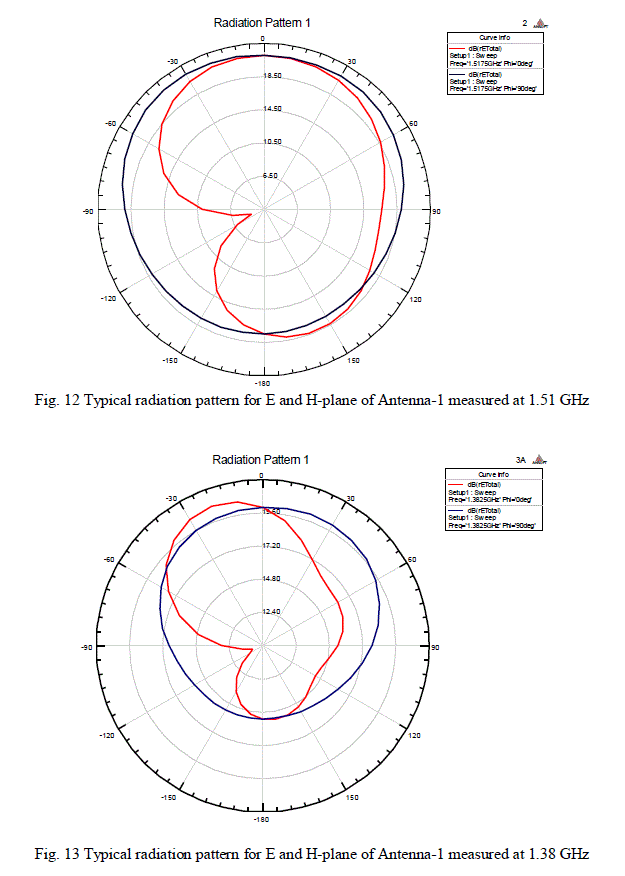 |
| Since Antenna-1 gives highest bandwidth of 90.70% with a virtual size reduction of 33.33% when Lg=2.13 cm. Its current distribution is shown in Fig. 14. The Antenna-1 gives the highest virtual size reduction of 50% when Lg=1.53 cm. Its current distribution is shown in Fig. 15. From these two figures it is clear that, the current is mainly concentrated on the top and bottom portion of the patch with very low density at the centre and it is distributed along the edges of the patch indicates wide band operation |
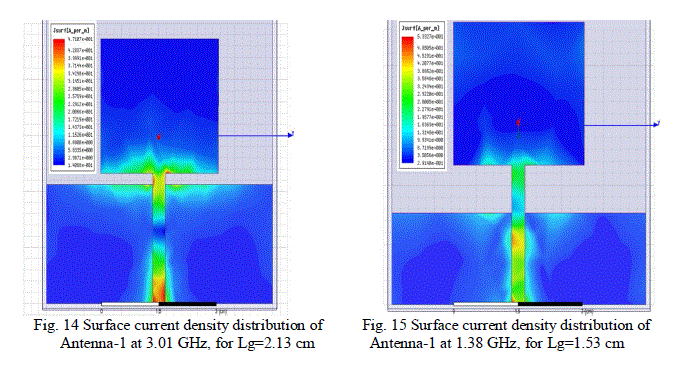 |
CONCLUSION |
| From the detailed study it is found that, the bandwidth and virtual size reduction can be enhanced without any modification of the rectangular patch. The CRMSA is simplified by using single microstripline feed. The technique used in this study is found to be more simple and easy. The 25% smaller substrate area compare to the substrate area of CRMSA are used for the construction of MRMSA gives 3.71% of bandwidth. This bandwidth has been enhanced to 90.70% with a virtual size reduction of 33.33% by using 64.5% smaller ground plane compare to the ground plane used for MRMSA. Further highest virtual size reduction of 50% is obtained by using 74.5% smaller ground plane compare to ground plane of MRMSA. The reduction of ground plane also enhances the gain of CRMSA from 2.17 to 3.56 dB. The enhancement of bandwidth, virtual size reduction and gain does not affect much the nature of broad band characteristics. The proposed antennas may find application in WLAN. |
References |
|